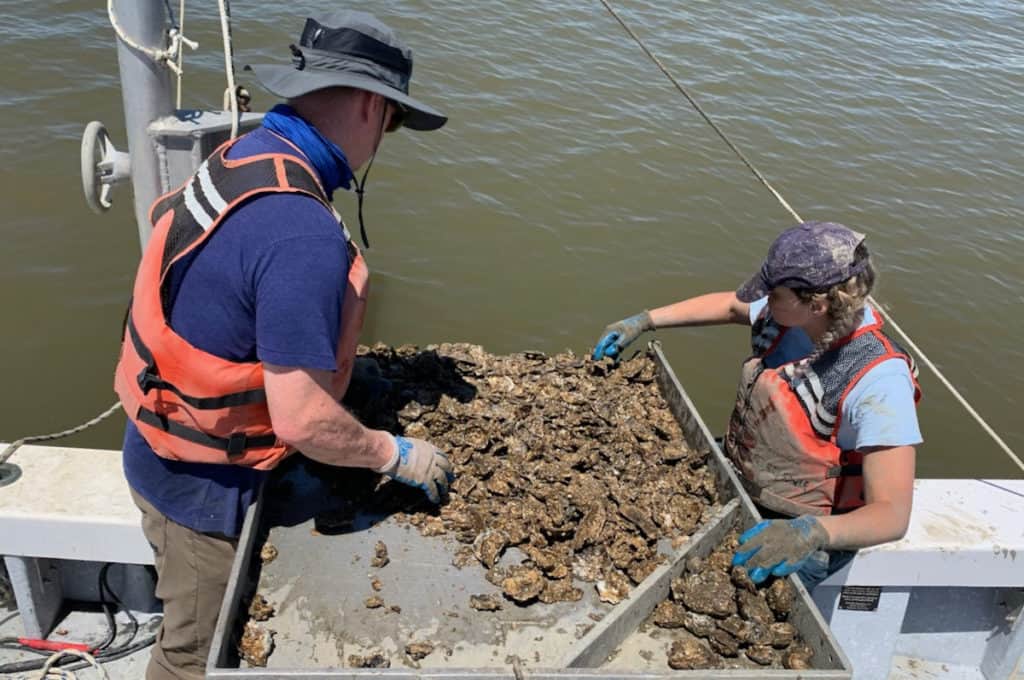In 1986, oyster disease decimated Chesapeake stocks, especially in the upper Bay. The kill was sudden, brutal, and devastating. And the culprit, Dermo, appeared to have been living here for years at less lethal levels. For the first time ever, Maryland’s harvest dropped below one million bushels, and—even worse—in a few years, below 100,000 bushels. The kill devastated the industry, especially in places like Deal, Smith, and Tangier islands with few other sources of winter income. Of course, it didn‘t help fish/crab habitat or water quality either.
Scientists blamed the kill on persistent mid-1980s droughts and heat that raised the Chesapeake’s salinity, allowing Dermo to spread further north than usual. A contributing factor may have been movement of infected James River seed oysters to Maryland reefs for planting. While the industry and the Bay suffered, scientists and watermen in both states worked together for solutions to revive the industry with development of disease-tolerant oysters, more efficient aquaculture systems, and reef restoration that included leaving more of the (presumably disease-tolerant) survivors in the water. Then a funny thing happened. Rains returned to the Chesapeake watershed, dropping Bay salinity, but Dermo remained a threat. Maybe the droughts weren’t the cause?
Fast-forward 35 years, as Dr. Ryan Carnegie of the Virginia Institute of Marine Science (VIMS) and colleagues from New Jersey, South Carolina, and VIMS began to scrutinize the old conclusion about drought and heat. What they discovered has big implications for future oyster management and research, and affirms the value of basic, year-to-year environmental monitoring, even when there is no immediately obvious payoff.
The team studied tissues of oysters preserved on a year-to-year basis in collections of all three states’ labs. Sure enough, south to north, the Dermo parasites suddenly changed in form in the mid-80s, with smaller cells infecting the lining of the oysters’ digestive tracts instead of deeper connective tissue. The new strain also displayed a new reproductive strategy. In Bay oysters, the new variant increased in frequency from 22 percent to 99 percent between 1985 and 1986. Most oysters could not adapt to this sudden onslaught fast enough. Most, but not all. Just as protozoan parasites like Dermo evolve, so do shellfish like oysters. The process has been achingly slow, but the remnant of disease-tolerant oysters that survived the “massacre” of 1986 have produced new generations of Chesapeake oysters whose trends are slowing rising, partly from momentous human effort and a lot from Mother Nature. Other findings led to the idea that Dermo’s increased virulence was the result of evolutionary pressure from the Chesapeake’s other deadly oyster disease, MSX. You can read more here about the study Dr. Carnegie and his team published recently in the journal Scientific Reports.
“Our work underscores the importance of long-term environmental monitoring,” Dr. Carnegie remarked. “Without that, and the maintenance of associated natural history collections, this new perspective wouldn’t have been possible.” There was a time (the ‘50s and ‘60s) when some molecular biologists referred to monitoring and building natural history collections as stamp collecting. No more. Thanks for this lesson, Dr. Carnegie and team.
-John Page Williams




